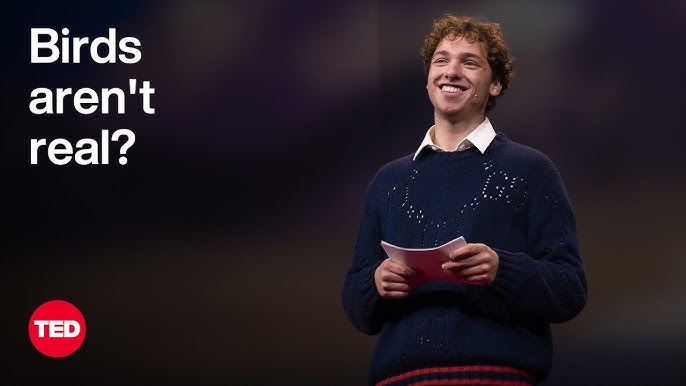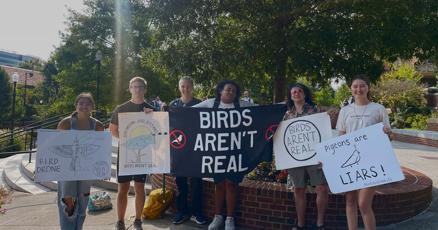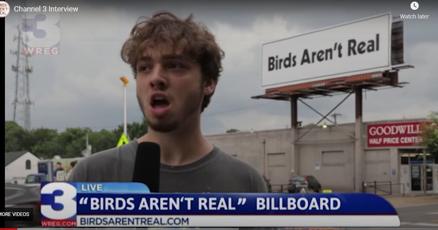Birds Aren't Real: From Satire to Media Literacy Tool

The internet is a breeding ground for information, both accurate and otherwise. In this digital landscape, it's increasingly difficult to discern fact from fiction. Enter the "Birds Aren't Real" movement, a peculiar phenomenon that claims all birds in the United States were replaced by government surveillance drones from 1956 to 2001. While seemingly absurd, this conspiracy theory, spearheaded by Peter McIndoe, cleverly evolved from a satirical jab at conspiracy culture into a unique tool for media literacy education, forcing us to confront the spread of online misinformation and the importance of critical thinking skills online.
The Absurd Origins of "Birds Aren't Real"
The "Birds Aren't Real" theory emerged from the mind of Peter McIndoe in 2017. Frustrated by the prevalence of conspiracy theories, McIndoe sought to create his own, one so outlandish that it would expose the ease with which misinformation could gain traction. The result was the assertion that birds were not what they seemed – a satirical commentary on conspiracy culture.
Early tweets from McIndoe showcased the intentionally ridiculous nature of the claims. He tweeted outlandish statements about birds being equipped with cameras and listening devices, controlled by the government to spy on citizens. These tweets, often accompanied by deliberately poor grammar and inflammatory language, gained traction, spreading the "Birds Aren't Real" message far and wide. The satirical content was unmistakable, yet the theory began to attract genuine believers, highlighting the danger of satirical conspiracy theories.
Twitter: Fueling the Fire (and the Satire)
Twitter played a crucial role in the evolution of "Birds Aren't Real". McIndoe masterfully used the platform to amplify the absurdity, posting increasingly outlandish claims and engaging with both believers and skeptics. This created a feedback loop, where the satire became more elaborate and self-aware. The movement tapped into the existing anxieties about government surveillance and data privacy, issues which are very valid. However, "Birds Aren't Real" used them as a vehicle to push the absurd, showcasing how Twitter misinformation spread.
College Campuses: A Platform for Protest and Parody
The "Birds Arent Real" movement found fertile ground on college campuses. Students, often at the forefront of social and political activism, embraced the theory as a vehicle for protest and awareness campaigns. The movement's message quickly evolved beyond the initial satire and started to touch on broader issues around truth and media literacy.

Protests, often theatrical and humorous, became a staple of the movement. Students organized demonstrations, holding signs emblazoned with slogans like "Birds Aren't Real," "Wake Up America," and "Birds Work for the Bourgeoisie." These events were not just about promoting the conspiracy; they were about encouraging critical thinking skills online and questioning the information presented to them. The movement became a way for students to grapple with misinformation on college campuses.
Mainstream Media: Recognizing the Educational Potential
Mainstream media outlets, including The New York Times, Vice, and NPR, took notice of the "Birds Aren't Real" phenomenon. Their coverage focused on the movement's satirical nature and its potential as a tool for media literacy education. These articles highlighted the ease with which misinformation can spread in the digital age and the importance of teaching individuals how to critically evaluate sources.

These media outlets didn't just report on the absurdity; they explored the underlying message about online misinformation education. They framed the movement as a case study in how satire can be used to engage people in discussions about digital literacy and evaluating sources online.
Dr. Emily Vraga on the Power of Absurdity
Dr. Emily Vraga, a professor specializing in media literacy and political communication, offers valuable insight into the movement's impact. "The 'Birds Aren't Real' movement, while initially appearing absurd, provides a valuable framework for young people to engage with and deconstruct the often-opaque world of online information. Its very absurdity forces critical evaluation." This quote encapsulates the core of the movement's educational potential.
Dr. Vraga further suggests, "By presenting a completely ridiculous claim, 'Birds Aren't Real' bypasses the typical defenses people have when confronted with information that challenges their existing beliefs. People are more likely to engage with the idea because it's funny, and in doing so, they inadvertently practice critical thinking skills." This playful approach allows individuals to question information without feeling attacked or defensive, which in turn aids online misinformation education.
Birds vs. Drones: Separating Fact from Fiction
It's crucial to remember the difference between harmless satire and genuine misinformation. While "Birds Aren't Real" is a deliberate parody, real-world conspiracy theories can have harmful consequences.

Understanding avian biology and the realities of government surveillance practices is essential in discerning the truth. "Birds Aren't Real" aims to prompt this very investigation, highlighting the importance of fact-checking and reliable sources. This includes using critical thinking to evaluate whether the source is credible or just trying to create satirical conspiracy theories.
The "Birds Aren't Real" Documentary Analysis
The "Birds Aren't Real" movement gained more traction with the release of a full length documentary in 2022. The film explores the character of Peter McIndoe as he travels the United States, speaking at rallies and events in support of the cause. Many critics found the film to be a commentary on modern day misinformation, as McIndoe struggles to maintain his character despite the movement getting a cult following.

The documentary allowed audiences to see first-hand how one can create a movement out of nothing. This exploration allows viewers to dive deep into satire as media education tool.
Is "Birds Aren't Real" dangerous?
While Peter McIndoe may have had good intentions at the beginning, many were worried about what the movement would become. As the movement gains steam, more and more people started to genuinely believe that birds are not real. This leads to a very important question; Is Birds Aren't Real dangerous? Some people belive that while Birds Aren't Real is a funny joke, it has the potential to lead people down darker rabbit holes of misinformation. By engaging with absurd conspiracy theories like "Birds Aren't Real", people might become more susceptible to believing other, more harmful conspiracy theories.
How to Improve your Media Literacy Skills?
Now that you understand the basics of the movement, what can you do to improve your media literacy skills?
- Question everything: Always ask questions about the source, author, and purpose of the information.
- Diversify your sources: Don't rely on a single news outlet or social media platform.
- Check the facts: Use fact-checking websites like Snopes or PolitiFact to verify information.
- Be aware of your biases: Recognize that everyone has biases, and be mindful of how they might influence your interpretation of information.
- Slow down: Take your time when consuming information, and don't rush to share or believe something without first verifying it.
- Understand cognitive bias: Learn about cognitive biases and how they can affect your judgment and decision-making.

These are all ways to improve your ability to source good information and ignore bad information. This will also help you better identify satirical conspiracy theories.
The Role of Humor in Social Commentary
The reason why the "Birds Aren't Real" movement took off is because it's funny. McIndoe masterfully used humor to make light of the current political situation in the United States. But what is The Role of Humor in Social Commentary? Humor is disarming and gets the audience to let their guard down and listen. Using humor is also a great way to show that people should be aware of online misinformation. The movement isn't just funny, it's also meant to cause people to think about what they are reading. Is the Birds Aren't Real theory a parody? Yes. Is there also an underlying message? Yes.
History of Satirical Movements
The "Birds Aren't Real" movement is not the first satirical movement to grab people's attention. Satire has been used throughout history to criticize political issues in a way that also entertains people. Another example of a History of Satirical Movements is the Church of the SubGenius. The Church of the SubGenius is an American parody religion that was created in 1979. It satirizes religion, pop culture, conspiracy theories, and various social norms. The church is built on the idea that "slack", the ability to easily navigate through life, is the only thing that matters. These movements aren't just funny, they are supposed to provoke a response from viewers.

The Psychology of Conspiracy Theories
To understand why the "Birds Aren't Real" movement has taken off, you have to understand the Psychology of Conspiracy Theories. Some people are drawn to conspiracy theories because they provide a sense of control and understanding in a complex world. Conspiracy theories often offer simple explanations for complicated events, which can be comforting. They can also create a sense of community and belonging among believers.

Because of the need to feel in control, people are more likely to spread online misinformation.
Conclusion: Embracing Critical Curiosity
The "Birds Aren't Real" movement is a testament to the power of satire and its potential for media literacy education. While the theory itself is absurd, it serves as a valuable reminder to question the information we encounter online and to think critically about the sources we trust. In a world saturated with misinformation, embracing critical curiosity is more important than ever. Want to test your media literacy skills? Explore reputable resources on fact-checking and media bias to sharpen your ability to discern truth from fiction.